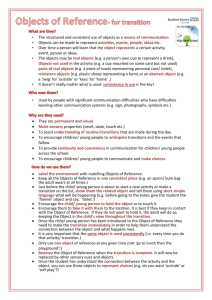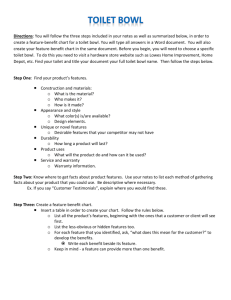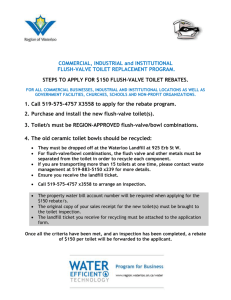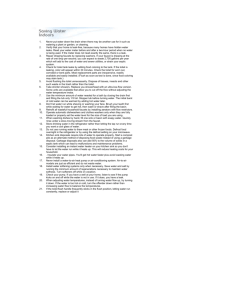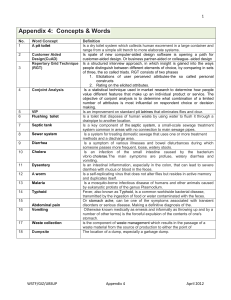Toilet Training 101
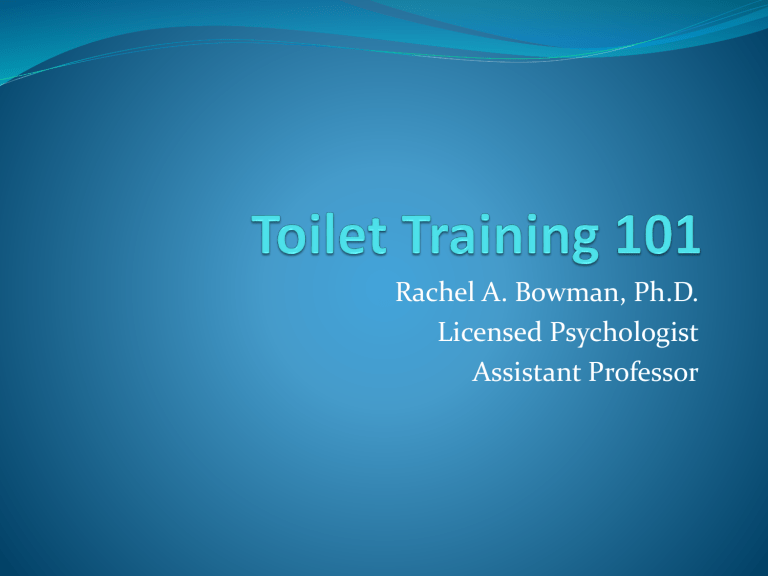
Rachel A. Bowman, Ph.D.
Licensed Psychologist
Assistant Professor
Overview
Strategies to improve compliance in children
Pre-requisite skills for successful toilet training
Basic behavioral strategies for teaching toileting skills
How to know when to consult a professional
Rationale for Teaching Compliance
Skills First
If child does not follow most basic simple directions, he/she will not be compliant with toileting skills
Important for child to learn that following directions leads to positive outcomes (positive reinforcement)
Parent needs to learn how to give effective directions and prompts and how to deliver reinforcement for basic directions first
Giving Effective Instructions
Get the child’s attention first
Say what you want the child to do rather than what not to do
Give one instruction at a time
Be specific
Give as sentences not as questions
Comprehension
Use gestures
Neutral voice
Time the explanation
3-step guided compliance
1. Tell
2. Show
3. Help
3-step guided compliance
TELL STEP
State child’s name
Tell child what to do (don’t ask)
State the request clearly
Wait 5-10 seconds. Do not repeat your instruction
If the child complies, give a specific praise and/or other preferred items
3-step guided compliance
SHOW STEP
If the child doesn’t comply, repeat the instruction with a gesture.
If the child complies following the verbal and visual cues, give a specific praise and/or other preferred items.
3-step guided compliance
HELP STEP
If the child still doesn’t comply, repeat the instruction and use hand-over-hand prompting to gently guide the child to comply.
Do not provide any praise or reward following the use of a physical prompt.
“Broken Record” Technique
Alternative compliance strategy for older children who are physically larger in size
Can be more helpful with children who are averse to physical touch or physical guidance
Tougher to use than 3-step guided compliance because you have to “out-wait” the child
“Broken Record” Technique
TELL STEP
State child’s name
Tell child what to do (don’t ask)
State the request clearly
Wait 5-10 seconds. Do not repeat your instruction
If the child complies, give a specific praise and/or other preferred items
“Broken Record” Technique
SHOW STEP
If the child doesn’t comply, repeat the instruction with a gesture.
Repeat the last step every 5-10 seconds until the child complies.
Ignore any other behavior or verbalizations.
When the child complies calmly, give a specific praise.
Five Reasons to Take on Toilet
Training
1.
Children who are toilet trained may have more self-confidence and personal comfort.
1
2.
Individuals who are toilet trained are more independent and experience greater social acceptance.
2
3.
Assisting a child becomes more physically demanding as children mature.
4.
There's an immediate and lasting financial benefit as day-to-day costs for diapers increase with age.
5.
Toilet training often is an IEP goal since it is important for independence.
1 Cicero, F. R., & Pfadt, A. (2002). Investigation of a reinforcement-based toilet training procedure for children with autism. Research in Developmental Disabilities, 23, 319-331.
2 Sells-Love, D., Rinaldi, L. M., & McLaughlin, T. F. (2002). Toilet training an adolescent with severe mental retardation in the classroom: A case study. Journal of Developmental and Physical Disabilities, 14, 111-118.
Pre-requisites for Successful Toilet
Training
Child should be able to walk independently
Child should have some fine motor skills
Child should have basic receptive language skills
Parent should receive training in compliance skills
Child should be compliant with 70-80% of parental directions
Intact neurological and muscular control
MOST IMPORTANT: Parents and school should be
100% committed to working very hard!
Materials for Successful Toilet
Training
Regular underwear so child can feel wetness
Elastic-waist pants for easy pull-up
Child-size potty or other modifications to regular toilet
Preferred beverages
Effective reinforcers (rewards)
Timer
Data collection sheets
Effective Reinforcers
What matters the most to your child? What will he/she consistently work for?
Is this an item or activity that I can easily limit my child’s free access to?
Does this item or activity cause any behavior problems when my child has it or when it is removed?
Variety is best
Very small reinforcer that can be delivered every 30-60 minutes throughout the day
Bigger, more special reinforcer for voiding on toilet
Toilet Training Steps
Regularly scheduled dry pants checks
Prompt child to feel for “wet” or “dry”
Reward dry pants (cheering + small reinforcer)
If child is wet or soiled, use 3-step guided guidance for child to assist in clean-up
Toilet Training Steps
Regularly scheduled trips to the toilet
The timing of these trips are based on your baseline data collection
Prompt child to communicate their need to use the toilet
Say “potty”
Sign “potty”
Touch picture of potty
Toilet Training Steps
Calmly walk child to the toilet
Use 3-step guided compliance for child to pull pants down
Have child sit for no more than 5 minutes
Praise for good sitting
Some children need a book or other item to help them relax
Toilet Training Steps
Reward child if he/she goes on potty (praise + large reinforcer)
After 5 minutes are up, use 3-step guided compliance for pulling pants up
Use 3-step guided compliance for hand-washing
Data Collection
Helpful to have a baseline to determine how often to schedule bathroom practice
Patterns and frequency of urination – does my child need more fluids?
Patterns of frequency and timing of bowel movements
– does my child have regular bowel movements? constipation problems?
Data sheets provide objective information about your child’s progress
What To Do if the “Positive
Approach” is not Working
Positive practice for continued accidents
Parent uses 3-step guided compliance and displays
“robot face and voice”
Guides child back to scene of accident
Escorts child to bathroom
Prompts child to pull down pants
Prompts child to sit on toilet
Prompts child to pull up pants
Repeat 5-10 times
What To Do if the “Positive
Approach” is not Working
Response-cost approach
Removing sticker, star, or point from star
Taking away highly-preferred item or activity
When do I Need to Consult a
Professional?
If you are unsure if your child has a medical or neurological problem that could prevent successful toilet training
If your child has frequent constipation or withholds stool
If your child has extreme fear or anxiety about going in the bathroom or sitting on the toilet
If your child has significant disruptive behavior problems
(e.g., noncompliance, tantrums, aggression) with directions or other routine activities
If you have had unsuccessful attempts at previous toilet training
Toilet Training Challenges
Going in the wrong location
Problems with sitting to have a bowel movement
Anxiety with public restrooms (e.g., automatic flushers and hand dryers)
Fear of sitting on a toilet
Constipation
Going in the Wrong Location
Pair sensation of eliminating with being in the bathroom
First step is to get child to void in their pull-up while in the bathroom
Making it fun and relaxing
Gradually shape child to sit on toilet
Problems with Sitting on the Toilet
Make it fun and relaxing
Modifications to toilet to make child more comfortable
Relaxation training (for you and your child)
Systematic desensitization – go slow!
“Camp out” in the bathroom until he/she goes
Use effective rewards
Use visual cues and pictures of steps and rewards
Anxiety About Using Public
Restrooms
Assess specifics of anxiety
Relaxation training
Systematic desensitization and exposure – very slow!
Effective reinforcers
Use of visual cues and pictures of steps and rewards
The End
ANY QUESTIONS?
